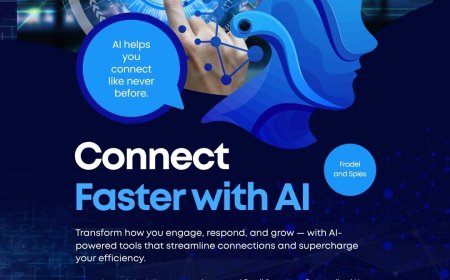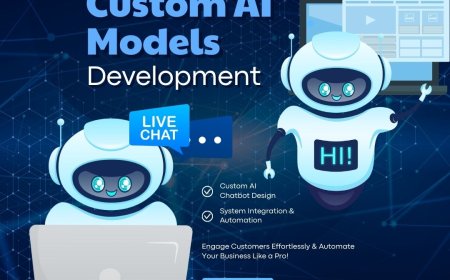How AI Voice Bot Development Is Redefining User Experience Across Industries in 2025
In 2025, AI voice bot development is revolutionizing how users interact with businesses across diverse industries. From personalized healthcare support and seamless banking interactions to intelligent retail assistance and 24/7 travel guidance, voice bots are enhancing customer experiences like never before.

In 2025, AI voice bot development has moved from being an experimental innovation to a mission-critical component of digital transformation strategies. No longer limited to basic virtual assistants, todays AI-powered voice bots are redefining user experience (UX) across industriesfrom healthcare and retail to banking and travel.
Fueled by breakthroughs in natural language processing (NLP), speech recognition, machine learning, and emotion AI, voice bots now offer seamless, intelligent, and deeply human-like interactions. Whether helping patients schedule appointments, guiding customers through a purchase, or assisting travelers on the go, these bots are delivering conversational experiences that are fast, personalized, and always available.
In this blog, well explore how AI voice bot development is transforming the way users interact with businesses across various sectors, the technologies behind this shift, and what it means for the future of UX.
The Rise of Voice as a User Interface
Over the last decade, user interfaces have evolved from keyboards and touchscreens to voice commands. With the widespread adoption of smartphones, smart speakers, and in-car voice systems, people have grown comfortable speaking to devices. In 2025, voice is no longer a noveltyits a primary mode of interaction.
This shift toward voice is driven by user demand for:
-
Speed Voice interactions are faster than typing.
-
Convenience Voice enables hands-free multitasking.
-
Accessibility Voice interfaces are inclusive for users with disabilities.
-
Humanization Talking feels more natural and engaging than tapping or clicking.
With this behavioral change, organizations are now investing heavily in voice bot development to stay competitive, offer better service, and enhance customer loyalty.
The Core Technologies Behind Modern AI Voice Bots
Voice bots in 2025 rely on a blend of advanced technologies that work together to deliver seamless and intelligent experiences:
? Automatic Speech Recognition (ASR)
Converts spoken language into text in real time. Tools like Google Speech-to-Text, Amazon Transcribe, and OpenAI Whisper power accurate ASR across multiple languages and accents.
? Natural Language Understanding (NLU)
Interprets user intent, extracts key data, and identifies sentiment. Advanced NLU engines like Dialogflow CX, GPT-4, Rasa NLU, and Azure LUIS power contextual understanding.
? Text-to-Speech (TTS)
Generates natural-sounding voice responses. Tools like Amazon Polly, Google Cloud TTS, and Resemble.ai offer emotionally expressive voices and brand-personalized speech.
? Emotion AI
Analyzes voice tone, pitch, and speech patterns to detect emotions like frustration or excitement, allowing bots to respond with empathy and adjust their tone.
Industry-Wise Breakdown: How Voice Bots Are Transforming UX
Lets examine how AI voice bot development is reshaping user experiences across key industries:
?Healthcare: Accessible and Timely Patient Interaction
In healthcare, time and clarity are everything. Voice bots are now widely used to:
-
Schedule appointments and send voice reminders
-
Offer medication instructions and symptom checkers
-
Answer insurance and policy-related questions
-
Triage patients during emergencies or peak hours
User Experience Benefits:
-
24/7 access to care services
-
Reduced wait times and call center load
-
Multilingual voice support for diverse populations
-
Voice-enabled health updates on smart speakers or phones
??Retail and E-Commerce: Conversational Shopping at Scale
Retailers are leveraging voice bots to improve every step of the customer journeyfrom product discovery to post-purchase support.
Use cases include:
-
Helping customers find products through voice search
-
Assisting with order tracking and returns
-
Providing personalized product recommendations
-
Answering FAQs about sizes, shipping, and promotions
User Experience Benefits:
-
Instant, voice-driven answers without navigating complex menus
-
Voice-assisted shopping from mobile apps and smart devices
-
A human-like shopping assistant available 24/7
?Banking and Finance: Secure and Smart Self-Service
Financial institutions have adopted AI voice bots to offer fast, secure, and reliable support for account holders.
Capabilities include:
-
Balance inquiries, fund transfers, and bill payments
-
Real-time fraud detection alerts
-
Investment recommendations and wealth management guidance
-
Voice-based KYC and onboarding
User Experience Benefits:
-
Reduced dependence on branch visits or long phone waits
-
Secure voice authentication and transaction handling
-
Personalized financial advice on-demand
-
Accessibility for elderly or non-tech-savvy customers
??Travel and Hospitality: Voice-Enabled Personal Assistance
AI voice bots are now acting as virtual travel concierges, offering real-time assistance before, during, and after trips.
Theyre helping users:
-
Book flights, hotels, and transportation
-
Get real-time flight updates or itinerary changes
-
Find local dining or tourist attractions
-
Provide emergency assistance in multiple languages
User Experience Benefits:
-
Hands-free travel support through smartphones or in-room devices
-
Streamlined booking and check-in processes
-
Tailored travel experiences based on user preferences
?Telecom: Instant Troubleshooting and Account Support
Telecom providers are using voice bots to resolve user issues faster and reduce strain on support teams.
Key use cases:
-
Internet connectivity troubleshooting
-
Plan upgrades and add-ons
-
Bill inquiries and payment assistance
-
SIM activation and number portability
User Experience Benefits:
-
Quicker resolution without hold times
-
Guided voice tutorials for device setup
-
Conversational IVR replacing outdated phone menus
The UX Impact: Beyond Functionality to Emotional Intelligence
In 2025, its not just what a voice bot doesits how it interacts. Emotional intelligence and human-like engagement are now essential to UX.
Heres how AI voice bots are elevating user experience:
? Personalization
Bots remember past interactions and tailor responses based on user preferences, purchase history, and tone.
? Empathy and Emotional Context
Bots respond differently when they detect user frustration, offering apologies or escalating to a human when needed.
? Consistency Across Channels
Whether a user engages on a website, mobile app, smart speaker, or phone, the bot offers a seamless, consistent experience.
? Speed and Convenience
Users get instant, accurate answers without navigating menus or waiting on holdenhancing satisfaction and brand trust.
Challenges to Address in Voice UX Design
While voice bots are powerful, developers and UX teams must overcome key challenges:
-
Misinterpretation of accents or background noise
-
Privacy concerns over voice data storage
-
Over-automationknowing when to escalate to a human
-
Inclusive design for different age groups, languages, and abilities
To succeed, organizations must follow best practices in conversation design, invest in continuous training, and collect user feedback to refine the bot experience over time.
The Future of AI Voice UX: Whats Next?
As voice technology evolves, expect even more personalized, proactive, and immersive experiences:
? Proactive Voice Interactions
Bots will anticipate user needs and initiate conversationslike reminding patients to refill prescriptions or alerting travelers of delays.
? Voice Biometrics for Security
Users will authenticate through their voiceprint, adding a frictionless layer of security to financial or healthcare interactions.
? Voice Bots in AR/VR Spaces
As immersive environments grow, voice will become the primary method of navigation and interaction in virtual spaces.
? Hyperlocal and Hyperpersonal Voice Experiences
Bots will adapt not just to user preferences but also to regional dialects, cultural norms, and local context.
Conclusion
In 2025, AI voice bots are not just answering questionstheyre redefining the user experience across every touchpoint. By combining speed, empathy, personalization, and omnichannel presence, voice bots are reshaping how users interact with brands across industries.
The result? More satisfied customers, reduced operational costs, and a competitive edge in a voice-first world.
Whether you're a healthcare provider aiming to improve patient access or a retailer seeking to deliver concierge-style support, now is the time to invest in AI voice bot development. The technology is here, the users are readyand the future is talking.













































